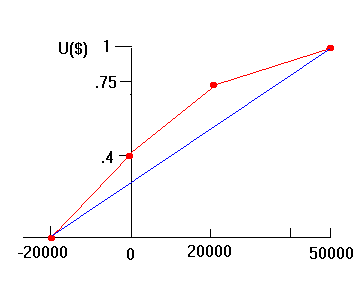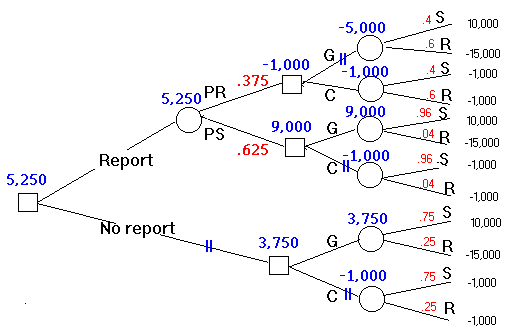Solutions to Assignment 9
14-1.
a)Laplace b)MaxMin c)MaxMax d)MinRegret
23.5 12 35 21
22.5 18 27 15
25 22 28 13
26.5 20 33 15
Regret Table:
Max
0 3 3 21 21
8 0 8 15 15
13 0 3 5 13
15 0 0 0 15
Laplace criterion chooses decision 4; MaxMin decision 3; MaxMax decision 1; and MinRegret decision 3.
14-2.
a) Laplace b)MaxMin c)MaxMax d)MinRegret
6.667 5 8 2
6 6 6 3
4.333 1 9 7
Regret Table:
Max
1 2 0 2
0 3 2 3
3 0 7 7
Laplace chooses decision 1; maxmin, decision 2; MaxMax, decision 3; and MinReget decision 1.
[go to top]
14-6.
a)
Small: (0 + 1000 + 2000 + 3000)/4 = $1,500
Medium: (-1000 + 0 + 3000 + 6000)/4 = $2,000
Large: (-3000 -1000 + 4000 + 8000)/4 = $2,000
Medium and Large tie for best
expected dollar return
b)Utilities of the payoffs from the graph:
Decision Cold Cool Warm Hot E(U)
Small .66 .73 .78 .83 .75
Medium .55 .66 .83 .93 .7425
Large .14 .55 .87 .98 .635
Small has the maximum expected utility. Working backwards with the utility graph (finding the $ value corresponding to the expected utilities of the alternatives) we find that "Small" has a certainity equivalent of about $1,800; "Medium" of about $1700 and "Large" less than $0.
[go to top]
14-8.
a) Equivalent lottery for a net cash flow of $0 is obtained from
p*50,000 + (1-p)*(-20,000)= $0 solving for p gives p = .28.
Equivalent lottery for a net cash flow of $20,000 is obtained
from p*50,000 + (1-p)*(-20,000)= $20,000 solving for p gives p =
.57.
b)  .
.
For me, the lottery of
winning 50,000 and loosing 20,00 is barely worth sure $0
if the probability of winning is .40, thus my
utility of a sure $0 is 0.4 ( > .28).
Likewise the lottery of winning $50,000 or loosing $20,000 is
just about as desirable as a sure
$20,000 if the winning probability is .75, thus
my utility for a sure $20,000 is .75 (> .57).
Therefore, my utility function for
money is given in red .
c)I am risk averse since my utility function is concave. To
accept a lottery (with risk) I demand a premium in the form of
higher winning probability (40% as opposed to 28% in the case of
$0; and 75% as opposed to 57% in the case of $20,000). If I were
risk indifferent my utility function would have been the blue
line for which the utility of
the lottery with expected value 0 and the sure 0 has the same
utility.
[go to top]
14-14.
a)
.25 .75
Decision Rainy Sunny E(V)
GO -15,000 10,000 $3,750
CANCEL -1,000 -1,000 $-1,000
b) Expected Value (EV) with perfect information:
.25 *(-1,000) + .75 *(10,000) = $7,250
Hence: Expected Value of Perfect Information (EVPI) = 7,250 -
3,750 = 3,500
[go to top]
14-15.
States of nature:
- Sunny: S
- Rainy: R
Result of report (Event):
- Predict Sunny: PS
- Predict Rainy: PR
Priors: P(S) = .75 P(R) = .25
power of prediction of the weather report: (conditional
probabilities)
P(PS|S) = .80 P(PS|R) = .10
P(PR|S) = .20 P(PR|R) = .90
Joint Probabilities (priors*conditionals:) and Marginals
P(PS and S) = .60 P(PS and R) = .025 P(PS) = .625
P(PR and S) = .15 P(PR and R) = .225 P(PR) = .375
Posteriors: (Joints/marginals)
P(S|PS) = .96 P(R|PS) = .04
P(S|PR) = .40 P(R|PR) = .60
The decision tree:
 Expected value of sample information (EVSI) is the difference
between expected dollar value with the report
which is $5,250 and expected dollar value without
the report which is $3,750.
Expected value of sample information (EVSI) is the difference
between expected dollar value with the report
which is $5,250 and expected dollar value without
the report which is $3,750.
Hence EVSI= $5,250 -
$3750 = $1500
[go to top]
 .
.